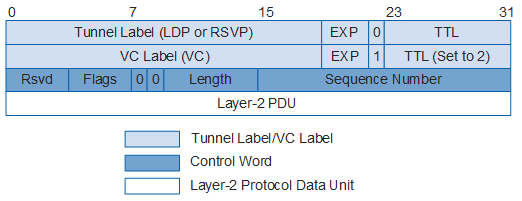Control Word
The Control Word is negotiated at the control plane, and is used for packet sequence detection, packet fragmentation, and packet reassembly at the forwarding plane. In the PWE3 protocols, ATM Adaptation Layer Type 5 (AAL5) requires support for the CW. The negotiation of the CW at the control plane is simple. If the CW is supported after the negotiation, the negotiation result needs to be delivered to the forwarding module, which detects the packet sequence and reassembles the packet.
The CW is a 4-byte encapsulated packet header, as shown in Figure 1. It is used to transmit packets on an MPLS packet switched network (PSN).
The CW has the following functions:
Carries the sequence number for forwarding packets.
If the forwarding plane supports the CW, a 32-bit CW is added before the data packet to indicate the packet sequence. When load balancing is supported, the packets may be out of sequence. The CW can be used to number the packets so that the peer can reassemble the packets.
Pads the packets to prevent the packets from being too short.
For example, if two PEs connect to each other over an Ethernet and CEs connect to PEs over PPP links, PPP negotiation cannot succeed because the size of PPP control packets cannot meet the minimum MTU requirements of an Ethernet. To prevent this problem, you can pad the CW as padding bits to the PPP control packet.
Carries the control information of the Layer 2 frame header.
In certain cases, the frame does not need to be transmitted completely in the L2VPN packets on the network. The frame header is stripped at the ingress and added at the egress. This method, however, cannot be used if the information in the frame header needs to be carried. You can use the CW to solve this problem. The CW can carry the negotiated information between the ingress PE and the egress PE.
At the control plane, the negotiation succeeds only when both ends or neither end supports the CW. At the forwarding plane, the negotiation result at the control plane determines whether the CW is added to a packet.
